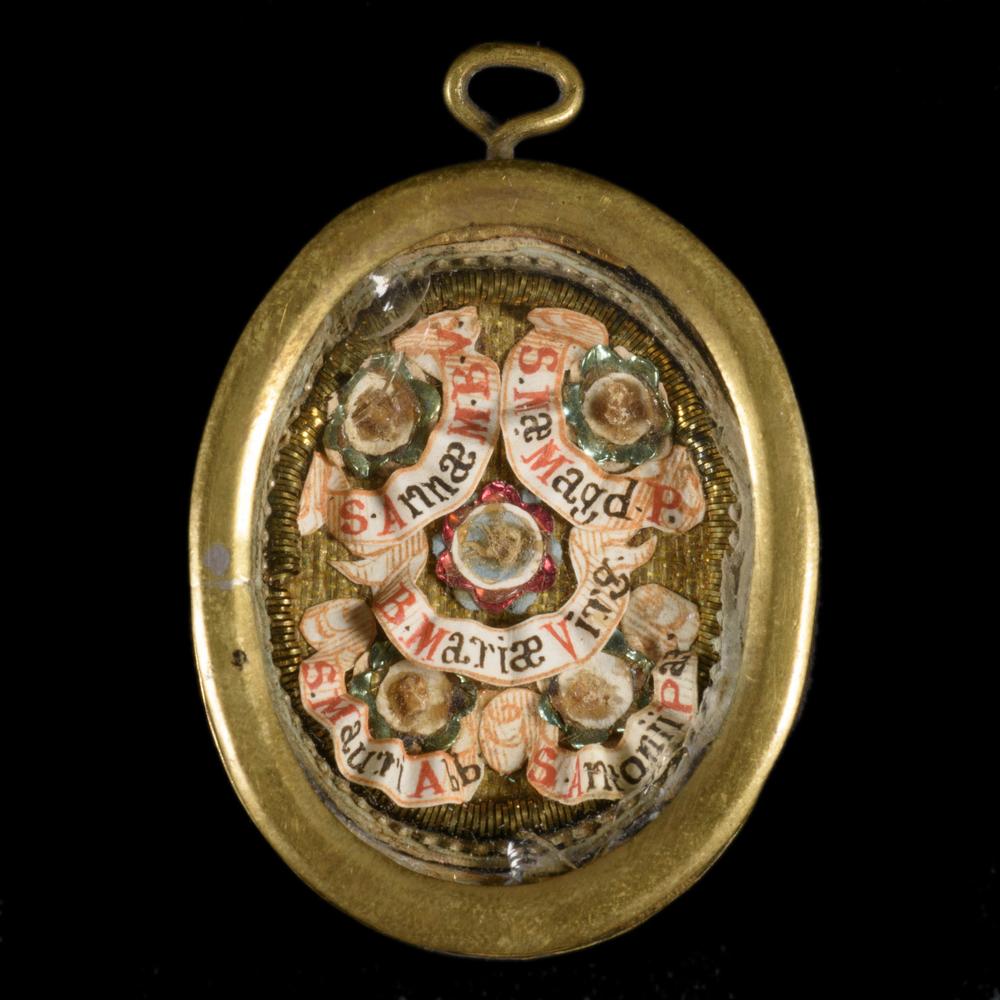RELIQUARY VIRGIN MARY AND 4 SAINTS
RELIQUARY VIRGIN MARY AND 4 SAINTS
Our prices are in euros, the prices converted in dollars or other currencies can vary according to the rate.
Free Worldwide Shipping – Secure and Protected Delivery
ref: #RK00-695Rare bronze reliquary with a glass front; the interior features an orderly composition in the shape of a rosette, at the center of which is a relic of the Blessed Virgin Mary (B. Mariae Virg.), surrounded by five other relics of saints. Each relic is enshrined in small ornamental compartments, often decorated with stylized flowers made of metal and colored paper.
Each relic is identified by a handwritten Latin label carefully cut and affixed to the support. These decorative labels serve as the primary interpretive elements of the object. They indicate the following saints:
-
S. Annae M. B. V. – Sanctae Annae Matris Beatae Virginis: Saint Anne, mother of the Virgin Mary.
-
S. Mae. Magd. P. – Sanctae Mariae Magdalenae Poenitentis: Saint Mary Magdalene, disciple of Christ and figure of penitence.
-
B. Mariae Virg. – Beatae Mariae Virginis: The Virgin Mary, at the center of the composition.
-
S. Maur. Abb. – Sancti Mauri Abbatis: Saint Maurus, Benedictine monk and disciple of Saint Benedict.
-
S. Anonii Pat. – Sancti Antonii Patavini: Saint Anthony of Padua, renowned Franciscan preacher.
Good condition with original glass.
Unopened.
Ecclesiastical seal and silk threads present.
PERIOD: 18th century
DIMENSION: 5 cm x 3.8 cm
SIZE: 2" x 1.5"
The choice of saints gathered in this reliquary is not arbitrary: it follows a devotional logic centered on the figure of the Virgin Mary and on the main spiritual pillars of Catholic piety — holy motherhood, penitence, monastic life, and intercession.
At the center of the composition is the Blessed Virgin Mary, heart of the Christian mystery of the Incarnation. Her central presence reflects her role as Mother of God, as well as Queen of Heaven, often depicted surrounded by saints in Baroque religious art. Here, she is the spiritual axis around which the small sacred circle is arranged.
Next to her stands Saint Anne, her mother, who embodies the holy lineage and the motherhood preparing for salvation. By venerating Anne, one symbolically ascends the spiritual genealogy of Christ, highlighting the role of generations in the transmission of faith.
Saint Mary Magdalene, another major figure, represents penitence and conversion. Close to Christ in the Gospel, she was the first to announce His resurrection. Her presence evokes divine mercy offered to sinners, as well as the fervor of purified love.
In contrast to this evangelical figure are two saints from monastic and apostolic tradition: Saint Maurus, disciple of Saint Benedict, embodies obedience, humility, and monastic stability — pillars of Benedictine life. He symbolizes renunciation of the world and the search for God through prayer and work.
Saint Anthony of Padua, meanwhile, represents the apostolic and preaching life. A 13th-century Franciscan, renowned for his knowledge of Scripture and his miracles, he is a powerful intercessor. His presence completes the ensemble by adding the dimension of inspired speech and teaching.
Thus, this reliquary forms a small heavenly community around the Virgin, illustrating different paths to holiness: holy motherhood (Anne), purity and mediation (Mary), conversion (Magdalene), monastic life (Maurus), and evangelical mission (Anthony). It offers the faithful a range of complementary spiritual models, all converging on Mary as the point of communion and intercession.
This kind of grouping reflects a harmonic and pedagogical vision of sainthood, as promoted in 17th-century Catholic spirituality: diverse in vocations, united in devotion.



